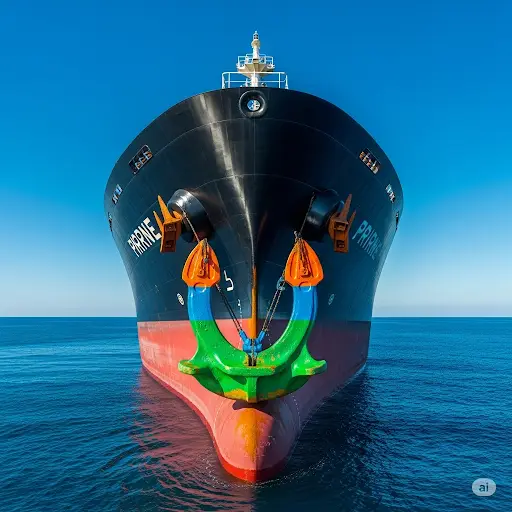The Red Sea’s Unseen Hand: How Maritime Terror Maintains Oil’s Price Floor Amidst Conflicting Signals
The global oil market this week has been a study in contradictions, a high-stakes game where visible supply data clashes with an invisible, yet potent, hand of geopolitical terror. Despite signals that might, in a bygone era, have sent prices into a tailspin, crude has maintained a resilient posture. The reason lies not in the familiar calculus of barrels produced versus barrels consumed, but in the escalating, undeniable threat emanating from the Red Sea. It is here that an unseen hand is now firmly gripping oil’s price floor, forcing a recalibration of risk across the entire energy complex.
As this Friday, July 18th, in New York, draws to a close, crude prices reflect this delicate balance. Brent Crude is currently trading around $69.34/bbl, and WTI Crude is near $67.39/bbl. This sideways movement over the week, despite bearish product inventory data, speaks volumes about the market’s ongoing struggle to fully price in a geopolitical premium that clashes with traditional fundamental signals.
The Market’s Conundrum: Supply vs. Geopolitics
The week opened with the clear intent of the OPEC+ alliance to add a substantial 548,000 barrels per day (bpd) to global supply in August. This strategic push, aimed at rebalancing the market and perhaps reclaiming share, normally exerts downward pressure.
Adding to this, last Wednesday’s EIA Weekly Petroleum Status Report (for the week ending July 11th) offered a mixed, yet ultimately concerning, demand picture. While U.S. commercial crude oil inventories saw a significant draw of 3.9 million barrels, a bullish indicator for crude itself, this was heavily offset by large builds in refined products. Gasoline inventories unexpectedly built by 3.4 million barrels, and distillate fuel inventories rose by 4.2 million barrels. These product builds often signal underlying weakness in consumer and industrial demand for fuels.
In a conventional market, these combined factors—increased supply from OPEC+ and softening demand indicators for refined products—would typically lead to a more pronounced price decline. However, the market’s relatively stable posture this week, with prices holding their range, underscores the powerful, overriding influence of geopolitical factors.
The Red Sea’s Relentless Grip: Escalation Confirmed
The narrative dominating the market remains the escalating situation in the Red Sea. This is no longer a distant threat; it is a brutal reality on the ground, or rather, on the water.
Recent intelligence indicates a tangible impact on shipping. News today confirms several Greek-managed tankers, often involved in carrying Russian oil to Asia, are now explicitly diverting around Africa to avoid the Red Sea. This significant shift follows deadly incidents and the sustained increase in war-risk insurance costs.
The chilling accounts from seafarers on the front lines underscore the gravity. A Filipino sailor recently recounted harrowing details of direct gunfire and a vessel being swarmed by rebels, highlighting the terrifying reality of navigating these waters. This personal testimony, combined with the confirmed sinkings of the MV Magic Seas and MV Eternity C (with tragic loss of life), paints a clear picture: the threat is consistent, immediate, and tragically effective. The Houthis are not merely signaling; they are strategically timing their attacks to maximize disruption, preventing any return to normal transit.
As a direct consequence, marine insurance premiums for Red Sea transits remain significantly elevated, with some reports showing them reaching up to 1% of a vessel’s value per voyage. This represents a direct, substantial increase in the operating costs for shipping lines, an overhead that inevitably translates into higher costs for transported goods, including oil.
The Anatomy of the Price Floor: A Structural Redefinition
What we are witnessing is far more than a temporary “geopolitical premium.” It is a fundamental, structural re-pricing of risk for global oil transit. The market is not simply adding a few dollars; it’s recognizing that the cost of delivering a barrel from source to consumer now includes a substantial, enduring element of geopolitical insecurity.
The EIA’s own upward revision of its 2025 Brent crude price forecast to $68.89/bbl, explicitly attributing it to “increased geopolitical risk,” serves as critical validation. This signals that even official, conservative forecasts now embed this risk as a permanent feature of the pricing landscape.
The combined impact of increased transit times (adding weeks to voyages), higher fuel consumption (around the Cape), and exorbitant insurance costs directly raises the “delivered” cost of crude. This intrinsic cost elevation creates a new, elevated price floor that is proving robust against otherwise bearish fundamental signals.
Global Supply Chain Under Siege
The Red Sea crisis lays bare the inherent fragility of modern, lean global supply chains. Designed for efficiency, they are ill-equipped for sustained, violent disruption to vital arteries. The ripple effects extend far beyond just oil:
- Broader Economic Impact: Higher shipping costs translate directly into increased prices for all goods, fueling global inflation and potentially dampening overall economic activity.
- “Just-In-Time” Vulnerability: The crisis profoundly challenges models that rely on predictable, efficient transit, forcing businesses to rethink inventory strategies and resilience.
- Corporate Adaptation: Major energy and logistics firms are now actively diversifying supply lines, increasing inventory buffers, and perpetually re-evaluating their routing strategies in real-time.
The Geopolitical Equation
The persistence of the Red Sea threat raises critical questions about the effectiveness of the international response. Despite naval deployments (like Operation Prosperity Guardian and EU Aspides), the Houthis continue to demonstrate capability and intent. This highlights the complex interplay of tactical limitations and the intractable political complexities of the broader regional conflict that fuels these actions.
Strategic Outlook: Navigating the New Baseline
As the week concludes, the market is solidifying a new equilibrium where the “cost of chaos” is an inherent, non-negotiable part of the price.
- Investor Sentiment: Long-term investors must now factor this heightened, persistent geopolitical risk into their valuations of oil assets and energy infrastructure.
- Key Indicators for Next Week: Operatives should monitor further shipping advisories, any shifts in Houthi capabilities or the broader regional conflict, and, critically, next week’s EIA data for U.S. inventory trends. The interplay between these will dictate short-term volatility.
Conclusion: The Invisible Price of Instability
As this week concludes, the message is clear: the invisible hand of geopolitical terror now exerts a powerful grip on the global oil market. The costs of instability are no longer theoretical; they are tangible, impacting every barrel that traverses the world’s most critical maritime arteries. For the discerning operative, understanding this re-calibration of risk is paramount. The game has changed. Stay vigilant.
Important Note on Volatility: The oil and gas market is experiencing significant volatility. Prices for crude oil, refined products, and associated logistical costs are changing rapidly. The figures quoted above reflect the general market situation as of Friday, July 18, 2025, New York Time. This is a fast-evolving situation, and continuous vigilance and reassessment are paramount.





